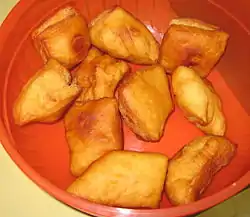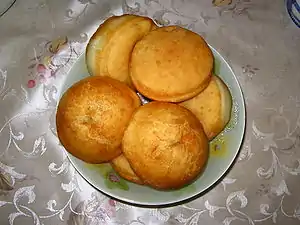Boortsog
Boortsog or bawïrsaq (Bashkir: бауырһаҡ, Kazakh: бауырсақ [bɑwərˈsɑq], Kyrgyz: боорсок [boːrˈsoq], Mongolian: боорцог [ˈpɔːrtsʰəq], Russian: баурсак, Tatar: Cyrillic бавырсак, Latin bawırsaq, Uzbek: bog'irsoq [bɒʁɨrˈsɒq], Tajik: бусроқ [buˈsrɒq], Turkish: pişi, bişi, tuzlu lokma, halka, Turkmen: pişme) is a type of fried dough food found in the cuisines of Central Asia, Idel-Ural, Mongolia and the Middle East.[1] It is shaped into either triangles or sometimes spheres.[2] The dough consists of flour, yeast, milk, eggs, margarine, salt, sugar, and fat.[3] Tajik boortsog are often decorated with a criss-cross pattern by pressing the bottom of a small strainer on the dough before it is fried.
 Homemade boortsog | |
| Alternative names | Boorsoq, bauyrsaq, baursak |
|---|---|
| Type | Fried dough |
| Course | Dessert |
| Main ingredients | Butter, salt water, milk, yeast, flour |
Boortsog is often eaten as a dessert, with sugar, butter, jam, or honey. They may be thought of as cookies or biscuits, and since they are fried, they are sometimes compared to doughnuts. Mongolians and Turkic peoples sometimes dip boortsog in tea. In Central Asia, baursaki are often eaten alongside chorba.[4]
Preparation
Dough for Boortsog ranges in ingredients from a simple dough, to a sweeter, crispier dough. For example, a typical Kyrgyz recipe calls for one part butter, 7 parts salt water, and 6 parts milk, along with yeast and flour, while more complex recipes add eggs and sugar. Also the dough could be made with Kaymak.
Boortsog are made by cutting the flattened dough into pieces. While not usually done in Central Asia, these pieces may be bent and knotted into various shapes before being deep fried. This is especially common among Mongolians. The dough is deep-fried golden brown. Mutton fat is traditionally used by Mongolians to give the boortsog extra flavor, but vegetable oil may be substituted.[5][6][7][8]
World records
The biggest (179 kg) baursak was cooked April 20, 2014 in Ufa, Russia. 1,006 eggs, 25 kg of sugar, 70 kg of flour, 50 kg of Bashkir honey were used for its preparation.[9] A Guinness record was made in Almaty, September 7, 2014 during the celebration of Mother's Day, when 856 kilograms of baursaks were cooked in one place in one day. The celebration was held in the form of a culinary battle between teams of mothers-in-law and daughters-in-law. Seven teams participated in the competition.[10]
See also
- List of doughnut varieties
- List of fried dough varieties
- Lokma
- Youtiao
- Chak-chak
- List of quick breads
- Shelpek – in a shape of a flat-bread
- Frybread
 Food portal
Food portal
Bibliography
- Mayhew, Bradley; John Noble (2007). Central Asia: Kazakhstan, Tajikistan, Uzbekistan, Kyrgyzstan, Turkmenistan. Multi Country Guide. Lonely Planet. ISBN 1-74104-614-9. Retrieved 12 November 2009.
- Schreiber, Dagmar (2008). Kasachstan: Auf Nomadenwegen zwischen Kaspischen Meer und Altaj (in German) (3rd ed.). Trescher Verlag. ISBN 3-89794-137-6. Retrieved 12 November 2009.
- Waters, Bella (2007). Kazakhstan in Pictures. Visual Geography (2nd ed.). Twenty-First Century Books. ISBN 0-8225-6588-9. Retrieved 12 November 2009.
References
- Waters (2007), 51.
- Mayhew and Noble (2007), 112.
- Schreiber (2008), 107.
- Schreiber (2008), 104.
- Recipe
- Recipe
- Recipe
- Kyrgyz frying boorsoq
- "В Уфе на изготовление самого большого баурсака России потратили 1006 яиц // ОБЩЕСТВО | новости башинформ.рф". www.bashinform.ru. Retrieved 2016-09-08.
- "Новый рекорд Гиннесса установили в Алматы в День Матери - Фрагменты жизни в Казахстане и мире – интересные истории | Tengrinews". Tengrinews.kz. Retrieved 2016-09-08.
External links
| Wikimedia Commons has media related to Bagirsaq. |
- Recipe
- Recipe
- Recipe
- Kyrgyz frying boorsoq
- My Home - Tatar cuisine recipes


